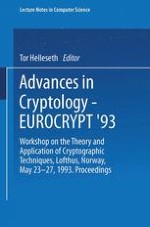Eurocrypt is a series of open workshops on the theory and application of cryptographic techniques. These meetings have taken place in Europe every year since 1982 and are sponsored by the International Association for Cryptologic Research. Eurocrypt '93 was held in the village of Lofthus in Norway in May 1993. The call for papers resulted in 117 submissions with authors representing 27 different countries. The 36 accepted papers were selected by the program committee after a blind refereeing process. The papers are grouped into parts on authentication, public key, block ciphers, secret sharing, stream ciphers, digital signatures, protocols, hash functions, payment systems, and cryptanalysis. The volume includes 6 further rump session papers.
